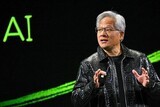The American tech world is pointing its compass in a bold new direction: beyond Earth.
As demand for AI computation rises at an unprecedented pace, global tech giants are exploring space as the next frontier for solving the industry’s escalating energy bottleneck.
Elon Musk, Jeff Bezos, Google, Nvidia and a wave of emerging space-tech players are accelerating plans for orbital data centers. These are massive computing facilities stationed outside Earth’s atmosphere, powered by uninterrupted solar energy and free from terrestrial regulations.

The Big Tech Battlefield Moves Off-Planet
According to The Wall Street Journal, Jeff Bezos recently predicted that gigawatt-scale orbital data centers will be operating within 10 to 20 years. Space, he argued, offers economic and logistical advantages that terrestrial infrastructure cannot match, including freedom from regulations, land constraints and limited power supplies.
Elon Musk is positioning SpaceX and Starlink as the backbone of a future space-based cloud. Leveraging Starship’s heavy-lift capacity, Musk envisions launching clusters of solar-powered AI servers into high-Earth orbit. He claims Starship could deliver as much as 100 gigawatts of annual power capacity within four to five years if technical challenges are solved. This equals roughly one quarter of annual U.S. electricity consumption.

Google and Nvidia Join the Orbital Computing Race
Google entered the arena this month with Project SunCatcher. The company argues that space could become the ideal energy and computing platform for the era of large-scale AI. It plans to launch two test satellites in early 2027 to validate hardware designed for space-based computation.
Nvidia, the dominant force behind AI chips, is also exploring orbital expansion. The company is partnering with the startup StarCloud to co-develop technology for GPU-powered clusters operating in orbit. This move would extend Nvidia’s influence beyond Earth.
Why Space? Because AI Demands Perfect Power Conditions
AI’s computational requirements are rising exponentially, pushing traditional data centers to their physical and economic limits. Since 2023, the shift toward ultra-large models has exposed four critical constraints: energy scarcity, cooling limitations, land shortages and delays caused by regulation.
Space provides solutions to all four.
The fundamentals driving orbital data center economics
24/7 solar exposure without weather or nighttime interruptions
Natural radiative cooling in the vacuum of space
Zero water usage, reducing one of the biggest burdens of modern data centers
Freedom from ground-based infrastructure regulations
As the cost of powering and cooling AI systems grows into one of the industry’s largest financial burdens, the promise of abundant and uninterrupted energy in orbit is reshaping long-term strategies across Big Tech.
A Crisis-Driven Shift and Why Experts See a 10-Year Timeline
Surging AI demand has pushed national power grids to the breaking point. The United States, facing mounting energy stress, declared an energy emergency shortly after President Trump took office. OpenAI has urged governments and corporations to secure at least 100 gigawatts of additional power capacity each year.
Some AI labs including Musk’s xAI have turned to temporary solutions such as gas-turbine power plants to maintain training cycles.
Against this backdrop, several experts argue that orbital data centers could become economically viable far sooner than expected, potentially within a decade. Former NASA scientist Phil Metzger calls the shift “the first practical business model for humanity’s expansion beyond Earth.”
The Countdown to Orbital Computing Has Already Started
Major challenges remain. Launch costs, long-term durability in extreme space environments and the difficulty of repairing systems hundreds of miles above Earth are all unresolved issues.
Even so, the direction is clear. The convergence of AI power shortages and the physical limits of Earth-based infrastructure is pushing the tech industry toward a future in which the most powerful computers operate beyond the planet.
Musk, Bezos, Google and Nvidia are not simply expanding into space. They are preparing for the next decisive battle in the global AI race, one in which energy, computation and technological leadership will increasingly be contested in orbit.
Tech Insiderㅣtlswnqor@naver.com
- “Even a Free Year Didn’t Work”...Google Gemini Struggles in Korea
- Google’s Third Delay in High-Precision Map Export: Korea Draws the Line Against Data Imperialism
- Google Plans to Build a “Solar-Powered Space Data Center” — Finding an AI Power Solution Beyond Earth
- Can Google’s Gemini 3 Become the Plot Twist That Restores Its Lost AI Dominance?
- OpenAI Ranked as Silicon Valley’s Second Most Vulnerable “AI Bubble” Company as Mounting Losses Raise Concerns
- Google Unveils Gemini 3 and Signals a New Phase in the AI Race
- Grok 4.1 Topped Every Benchmark in Emotional Intelligence, Creativity, and Accuracy. Hours Later, Gemini 3 Took the Crown

![[동학] 카카오톡 친구탭, 결국 12월 롤백… “격자형 피드는 선택 옵션으로”](https://cdn.kmjournal.net/news/thumbnail/custom/20251126/5517_10550_1119_1763853080_120.jpg)


![[테크 칼럼] 제미나이3, GPT-5.1을 넘다…AI는 이제 ‘일을 대신하는 시대’로 간다](https://cdn.kmjournal.net/news/thumbnail/custom/20251126/5457_10454_4847_1763621329_120.jpg)



![[낭만 테크 시대] AI 대항해 시대](https://cdn.kmjournal.net/news/thumbnail/custom/20251126/5603_10714_4334_1764121414_160.jpg)

